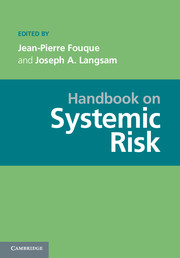Book contents
- Frontmatter
- Contents
- Contributors
- Introduction
- PART I DATA: THE PREREQUISITE FOR MANAGING SYSTEMIC RISK
- PART II STATISTICS AND SYSTEMIC RISK
- PART III MEASURING AND REGULATING SYSTEMIC RISK
- PART IV NETWORKS
- 11 Network Models and Systemic Risk Assessment
- 12 Strategic Interactions on Financial Networks for the Analysis of Systemic Risk
- 13 Network Structure and Systemic Risk in Banking Systems
- PART V SYSTEMIC RISK ANDMATHEMATICAL FINANCE
- PART VI COUNTERPARTY RISK AND SYSTEMIC RISK
- PART VII ALGORITHMIC TRADING
- PART VIII BEHAVIORAL FINANCE: THE PSYCHOLOGICAL DIMENSION OF SYSTEMIC RISK
- PART IX REGULATION
- PART X COMPUTATIONAL ISSUES AND REQUIREMENTS
- PART XI ACCOUNTING ISSUES
- References
11 - Network Models and Systemic Risk Assessment
from PART IV - NETWORKS
Published online by Cambridge University Press: 05 June 2013
- Frontmatter
- Contents
- Contributors
- Introduction
- PART I DATA: THE PREREQUISITE FOR MANAGING SYSTEMIC RISK
- PART II STATISTICS AND SYSTEMIC RISK
- PART III MEASURING AND REGULATING SYSTEMIC RISK
- PART IV NETWORKS
- 11 Network Models and Systemic Risk Assessment
- 12 Strategic Interactions on Financial Networks for the Analysis of Systemic Risk
- 13 Network Structure and Systemic Risk in Banking Systems
- PART V SYSTEMIC RISK ANDMATHEMATICAL FINANCE
- PART VI COUNTERPARTY RISK AND SYSTEMIC RISK
- PART VII ALGORITHMIC TRADING
- PART VIII BEHAVIORAL FINANCE: THE PSYCHOLOGICAL DIMENSION OF SYSTEMIC RISK
- PART IX REGULATION
- PART X COMPUTATIONAL ISSUES AND REQUIREMENTS
- PART XI ACCOUNTING ISSUES
- References
Summary
Abstract Over recent years a number of network models of interbank markets have been developed and applied to the analysis of insolvency contagion and systemic risk. In this chapter we survey the concepts used in these models and discuss their main findings as well as their applications in systemic risk analysis. Network models are designed to address potential domino effects resulting from the failure of financial institutions. Specifically they attempt to answer the question of whether the failure of one institution will result in the subsequent failure of others. Since in a banking crisis authorities usually intervene to stabilize the banking system, failures and contagious failures by domino effects are very rarely observed in practice. Empirical analysis is thus difficult and as a consequence most studies of insolvency contagion are built on simulation models. In this chapter we describe in some detail how such simulations are designed and discuss the main insights that have so far been obtained by applications to the complex network of real world exposure data of banking systems.
Keywords Contagion, Interbank Market, Systemic Risk, Financial Stability. JEL-Classification Numbers: G21, C15, C81, E44
Introduction
Will the failure of a financial institution be a threat to the stability of the banking system? This is a key question for authorities in the management of a financial crisis. At the height of a crisis the general level of uncertainty and the panic among market participants usually lead to stabilization policies and interventions of the public sector.
- Type
- Chapter
- Information
- Handbook on Systemic Risk , pp. 287 - 305Publisher: Cambridge University PressPrint publication year: 2013
References
- 35
- Cited by



